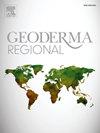摩洛哥农田土壤有机碳的国家基线高分辨率制图
IF 3.3
2区 农林科学
Q2 SOIL SCIENCE
引用次数: 0
摘要
土壤有机碳(SOC)在提高土壤肥力、改善保水、促进全球碳固存从而支持气候行动方面发挥着关键作用。在摩洛哥,以前的SOC制图工作主要依赖于传统方法,由于数据质量、可用性和外推误差,这些方法在捕捉SOC的空间变异性方面存在不足。本研究旨在利用数字土壤制图技术创建第一个国家农田土壤有机碳基线图。采用随机森林(random Forest, RF)、XGBoost和LightGBM三种机器学习(ML)模型进行比较,评估了摩洛哥农田土壤有机碳在250米分辨率下的空间变异性。通过从83个环境协变量(包括土壤性质、气候和水文因子、植被指数和人为活动)中选择最相关的预测因子,采用递归特征消除法优化模型性能。使用9926个地理参考样本,从0到30厘米的土壤深度以及环境数据,对模型进行了校准和验证。验证结果表明,ML模型在SOC预测中具有令人满意的预测性能,其中RF的准确率最高(R2 = 0.41;RMSE = 0.43%),表现出较低的不确定性,略优于XGBoost和LightGBM,两者均达到R2 = 0.39和RMSE = 0.43%。另一方面,为摩洛哥农田创建的SOM地图显示与全球SOC数据集(SoilGrids)的一致性有限,这表明后者不太适合捕获当地土壤特性。这些发现为摩洛哥农田建立了基本的SOC基线图,提供了对空间变异性的详细见解。该研究结果通过加深对不同尺度土壤碳动态的深入了解,为制定可持续农业战略、土壤保持和减缓气候变化的政策提供了支持。本文章由计算机程序翻译,如有差异,请以英文原文为准。
National baseline high-resolution mapping of soil organic carbon in Moroccan cropland areas
Soil organic carbon (SOC) plays a critical role in enhancing soil fertility, improving water retention, and contributing to global carbon sequestration and thereby supporting climate action. In Morocco, previous SOC mapping efforts have relied largely on traditional methods that fall short in capturing SOC's spatial variability due to data quality, availability, and extrapolation errors. This study aims to create the first national baseline SOC map for cropland using digital soil mapping techniques. Three machine learning (ML) models—Random Forest (RF), XGBoost, and LightGBM were compared to assess SOC spatial variability at 250-m resolution in Moroccan croplands. Recursive Feature Elimination was used to optimize model performance by selecting the most relevant predictors from 83 environmental covariates, including soil properties, climatic and hydrological factors, vegetation indices, and anthropogenic activities. The models were calibrated and validated using 9926 georeferenced samples from 0 to 30 cm soil depth alongside environmental data. Validation results demonstrated satisfactory predictive performance of ML models in SOC prediction, with RF achieving the highest accuracy (R2 = 0.41; RMSE = 0.43 %) and demonstrated low uncertainty, slightly outperforming XGBoost and LightGBM, which both achieved R2 = 0.39 and RMSE = 0.43 %. On the other hand, the created SOM map for Moroccan croplands displayed limited alignment with the global SOC dataset (SoilGrids), suggesting that this later is less appropriate for capturing local soil properties. These findings establish a foundational baseline SOC map for Moroccan croplands, providing detailed insights into spatial variability. The results support the recent policies aiming development of sustainable agricultural strategies, soil conservation efforts, and climate change mitigation through improving the in-depth understanding of soil carbon dynamics at various scales.
求助全文
通过发布文献求助,成功后即可免费获取论文全文。
去求助
来源期刊

Geoderma Regional
Agricultural and Biological Sciences-Soil Science
CiteScore
6.10
自引率
7.30%
发文量
122
审稿时长
76 days
期刊介绍:
Global issues require studies and solutions on national and regional levels. Geoderma Regional focuses on studies that increase understanding and advance our scientific knowledge of soils in all regions of the world. The journal embraces every aspect of soil science and welcomes reviews of regional progress.
 求助内容:
求助内容: 应助结果提醒方式:
应助结果提醒方式:


